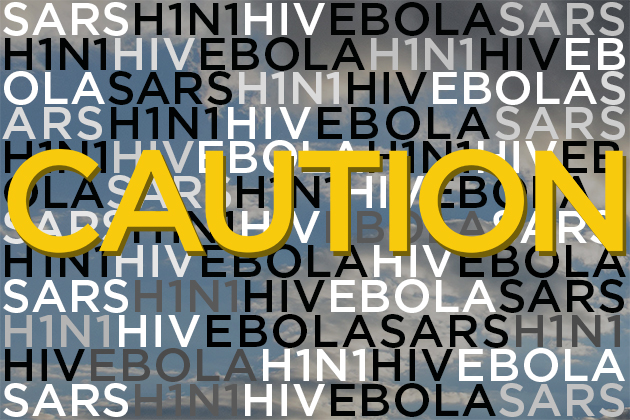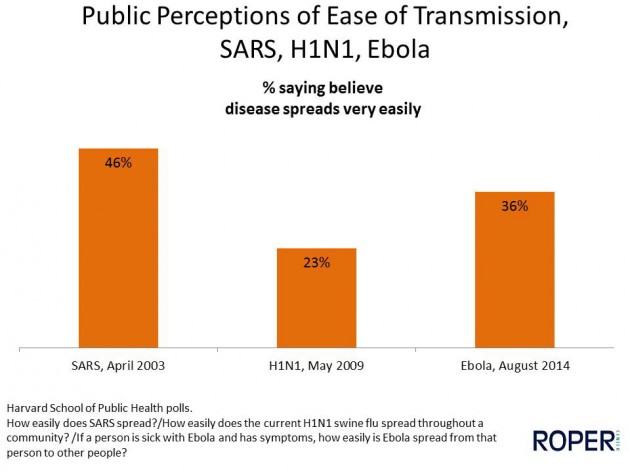The news stories now follow a familiar pattern: an outbreak of a new and frightening disease on another continent, the first cases found in the U.S., the speculation about the risk to the American population. The public has experienced this before: first SARS, then several waves of H1N1, and now Ebola. What did the public think during these earlier outbreaks, and what are they thinking now? From the Roper Center for Public Opinion Research archives:
Public watching Ebola story closely – and becoming concerned
A Fox News poll conducted at the end of September found 31 percent of respondents were very concerned, and 37 percent somewhat concerned, that the Ebola virus would spread from West Africa to the United States. Just a month earlier, a Harvard School of Public Health poll had found that only 19 percent were very concerned, and 18 percent somewhat concerned, about a large Ebola outbreak within the U.S. in the next year. At that time, the public was not particularly concerned about their own personal risk either. Just 25 percent in the same poll were very or somewhat concerned they or someone in their immediate family might get sick from Ebola in the next 12 months.
However, even in August, more than half (52 percent) of the country was already following the story somewhat or very closely. By September, more than 6 in 10 in a Kaiser Family Foundation poll were following the story fairly or very closely. A significant minority also saw an outbreak in the United States as at least somewhat likely. An August Reason/Rupe poll found that 11 percent of the public thought an outbreak in a U.S. city was very likely, and 29 percent thought it was somewhat likely.
How big a threat does the public believe Ebola to be?
If an outbreak were to occur, the public’s response would likely depend on several factors, including their physical proximity to the outbreak, the number of people infected, and the number of people who become seriously sick or die. The public’s perceptions of characteristics of the disease also influence their behavior.
One significant factor is perceived ease of transmission. Despite CDC assurances that Ebola is not spread through casual contact, in the August Harvard survey, 36 percent said they believed a symptomatic person could spread Ebola very easily, while 33 percent said somewhat easily. Looking back at the first spring of the H1N1 outbreak, 23 percent thought a symptomatic person would spread the flu very easily, while 45 percent said somewhat easily. The public believed SARS to be particularly transmittable – 46 percent in a 2003 Harvard poll believed that SARS spread very easily, and 35 percent somewhat easily.
Another major influence on the public’s sense of threat is their perception of the availability of treatment should they become infected. As researchers hunt for a specific medicine for the virus and treat current patients with basic interventions like IV fluids and oxygen, the public remains uncertain as to whether an effective treatment exists. In an August 2014 Harvard School of Public Health survey, a third (33 percent) of Americans said they believed there was an effective medicine to treat for Ebola, while a plurality of 45 percent said there was not. Just over 1 in 5 (22 percent) didn’t know. These numbers are similar to the proportions of the public who believed there was or was not a treatment for SARS in 2003. In comparison, in the early days of the HINI epidemic in spring 2009, 64 percent of respondents said there was an effective medicine to treat people who had contracted the H1N1, indicating that Americans were aware of the use of antiviral drugs to treat victims of that outbreak.
The lack of available treatment is likely to lead the public to react to an Ebola outbreak much as they would to a SARS outbreak. Although the relatively few cases of SARS in the U.S. in 2003 kept public response here subdued, the public response in Toronto – where there were many more cases and a number of deaths – was more significant, with major economic impacts.
Emerging infectious diseases as a public priority
Polls indicate that Americans consider emerging infectious diseases to be a significant public health priority. Although the public’s concerns about AIDS, Ebola, and other potential epidemics decreased slightly from 1998 to 2004, a majority of 55 percent still considered this threat critical, while an additional 34 percent considered it important. And the public believes investment of dollars in this problem where it begins could have a beneficial effect. A 2013 poll from Kaiser Family Foundation found that 68 percent of Americans believed spending money on improving health in developing countries helps protect the health of Americans by preventing the spread of diseases like SARS, bird flu, and swine flu.
This article was first published in the Huffington Post.






